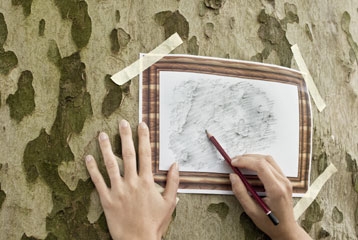Take rubbings from tree trunks to create works of art. This activity is organised as part of the “Vive nos arbres” project, aimed at promoting the heritage of Geneva’s trees.
This activity, which can be enjoyed the whole year round, encourages you to observe tree trunks in all their diversity. Using pencils, Néocolor chalk or charcoal, create works of art using rubbings of tree bark!
Duration
30 minutes
Material
- soft grey pencil (B or softer)
- sheet of paper
- charcoal or Néocolor chalk, if desired
- coach builder's tape, if desired
- a frame, if desired (to be downloaded at the bottom of this page)
Procedure
Choose the bark according to its low level of “roughness” and favour smooth trunks. The choice of where the rubbing is taken from the trunk is also important. A surface with a lot of relief will not provide a spectacular result and may damage your paper. Smoother barks, on the other hand, such as birch, beech and plane trees produce good results.
Hold the sheet of paper in one hand or fasten it to the tree using tape and rub the pencil across the paper with the other. Forms will soon appear.
Depending on your inspiration, you can vary the tones by using shades of grey or colour and by using Néocolor pencils or chalks.
To prolong the experience
More experienced artists can attempt to create mosaics by placing rubbings from different trees side by side.
Botanists can choose which trees to use according to their foliage (except in winter). An illustrated catalogue of the most common trees in Geneva is available on the “discover our trees” page of this website. To remember which rubbings you have taken and to refer to them at a later date, remember to label your artwork with the name and location of the tree.
Leaves also provide excellent rubbings, so why not enhance your work of art by superimposing the form of a leaf.
Did you know?
The bark of a tree is the equivalent of a person’s skin. They both serve the same protective function. The thickness and relief of the external layer varies according to the species and age of the individual. The bark protects the tree against temperature changes, cold snaps, heat waves, insects and fungi. Fungi can cause several diseases in trees.
Contact
Conservatoire et jardin botaniques - Système d'information du patrimoine vert - Arbres
1 Chemin de l'Impératrice
1292
Chambésy
Suisse
A télécharger
Article modifié le 27.02.2020 à 08:34

